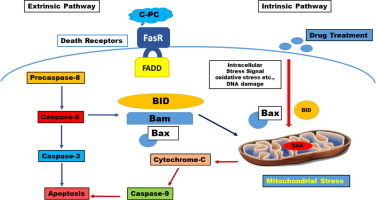当前位置:
X-MOL 学术
›
Bioorg. Med. Chem.
›
论文详情
Our official English website, www.x-mol.net, welcomes your feedback! (Note: you will need to create a separate account there.)
Molecular mechanism of C-phycocyanin induced apoptosis in LNCaP cells.
Bioorganic & Medicinal Chemistry ( IF 3.5 ) Pub Date : 2019-12-18 , DOI: 10.1016/j.bmc.2019.115272 Paramjot Kaur 1 , Sivanesan Dhandayuthapani 1 , Thiagarajan Venkatesan 1 , Miroslav Gantor 2 , Appu Rathinavelu 3
Bioorganic & Medicinal Chemistry ( IF 3.5 ) Pub Date : 2019-12-18 , DOI: 10.1016/j.bmc.2019.115272 Paramjot Kaur 1 , Sivanesan Dhandayuthapani 1 , Thiagarajan Venkatesan 1 , Miroslav Gantor 2 , Appu Rathinavelu 3
Affiliation

|
The usefulness of Marine-derived products as the source of anticancer agents has been explored for many decades. The objective of our study was to investigate the molecular mechanism by which C-PC induces apoptosis in monotherapy as well as in combination treatment with a known chemotherapeutic drug named Topotecan (TPT) using prostate cancer cells (LNCaP). To determine the intracellular mechanism of action, we analyzed the gene expression profile of C-PC treated cells using human apoptosis RT2 profiler PCR array, which indicated that C-PC was able to regulate both anti- and pro-apoptotic genes significantly. Detailed analysis revealed increases in the levels of Bax, Apaf-1 (pro-apoptotic proteins) along with the activation of the key apoptotic proteases such as caspase-8, caspase-9, and caspase-3. Similarly, analysis of anti-apoptotic proteins demonstrated a decrease in the expression of Bcl-2, Mcl-1, and survivin. Results from the whole-cell incubation studies indicated that C-PC was only binding to the plasma membrane-associated receptor proteins. LNCaP cells treated with C-PC alone and in combination with TPT showed increased expression of the death receptor FAS (also known as FAS or CD95) along with cleaved PARP, confirming its importance. Our study is significant since it is providing greater insight into the apoptotic mechanisms triggered by C-PC as well as emphasizing the involvement of FAS in mediating its effects. Furthermore, our results with combination treatments suggest that-PC could improve the anticancer effects of drugs such as TPT that are currently used for cancer treatments. In addition, use of C-PC in combination can also diminish the side effects resulting from conventional chemotherapeutic agents such as TPT.
中文翻译:

C-藻蓝蛋白诱导LNCaP细胞凋亡的分子机制。
数十年来,一直在探索海洋来源产品作为抗癌药来源的有用性。我们研究的目的是研究C-PC在单一疗法中以及与使用前列腺癌细胞(LNCaP)的已知化学疗法药物Topotecan(TPT)联合治疗中诱导凋亡的分子机制。为了确定细胞内的作用机制,我们使用人类凋亡RT2轮廓PCR芯片分析了C-PC处理的细胞的基因表达谱,这表明C-PC能够显着调节抗凋亡基因和促凋亡基因。详细的分析显示,Bax,Apaf-1(促凋亡蛋白)的水平增加,并且激活了关键的凋亡蛋白酶,例如caspase-8,caspase-9和caspase-3。相似地,抗凋亡蛋白的分析表明Bcl-2,Mcl-1和survivin的表达降低。全细胞温育研究的结果表明,C-PC仅与质膜相关受体蛋白结合。单独使用C-PC并与TPT组合处理的LNCaP细胞显示死亡受体FAS(也称为FAS或CD95)的表达以及裂解的PARP的增加,证实了其重要性。我们的研究意义重大,因为它为C-PC触发的凋亡机制提供了更深入的了解,并强调了FAS在介导其作用方面的参与。此外,我们的联合治疗结果表明,PC可以改善目前用于癌症治疗的药物(如TPT)的抗癌作用。此外,
更新日期:2019-12-19
中文翻译:

C-藻蓝蛋白诱导LNCaP细胞凋亡的分子机制。
数十年来,一直在探索海洋来源产品作为抗癌药来源的有用性。我们研究的目的是研究C-PC在单一疗法中以及与使用前列腺癌细胞(LNCaP)的已知化学疗法药物Topotecan(TPT)联合治疗中诱导凋亡的分子机制。为了确定细胞内的作用机制,我们使用人类凋亡RT2轮廓PCR芯片分析了C-PC处理的细胞的基因表达谱,这表明C-PC能够显着调节抗凋亡基因和促凋亡基因。详细的分析显示,Bax,Apaf-1(促凋亡蛋白)的水平增加,并且激活了关键的凋亡蛋白酶,例如caspase-8,caspase-9和caspase-3。相似地,抗凋亡蛋白的分析表明Bcl-2,Mcl-1和survivin的表达降低。全细胞温育研究的结果表明,C-PC仅与质膜相关受体蛋白结合。单独使用C-PC并与TPT组合处理的LNCaP细胞显示死亡受体FAS(也称为FAS或CD95)的表达以及裂解的PARP的增加,证实了其重要性。我们的研究意义重大,因为它为C-PC触发的凋亡机制提供了更深入的了解,并强调了FAS在介导其作用方面的参与。此外,我们的联合治疗结果表明,PC可以改善目前用于癌症治疗的药物(如TPT)的抗癌作用。此外,


























 京公网安备 11010802027423号
京公网安备 11010802027423号